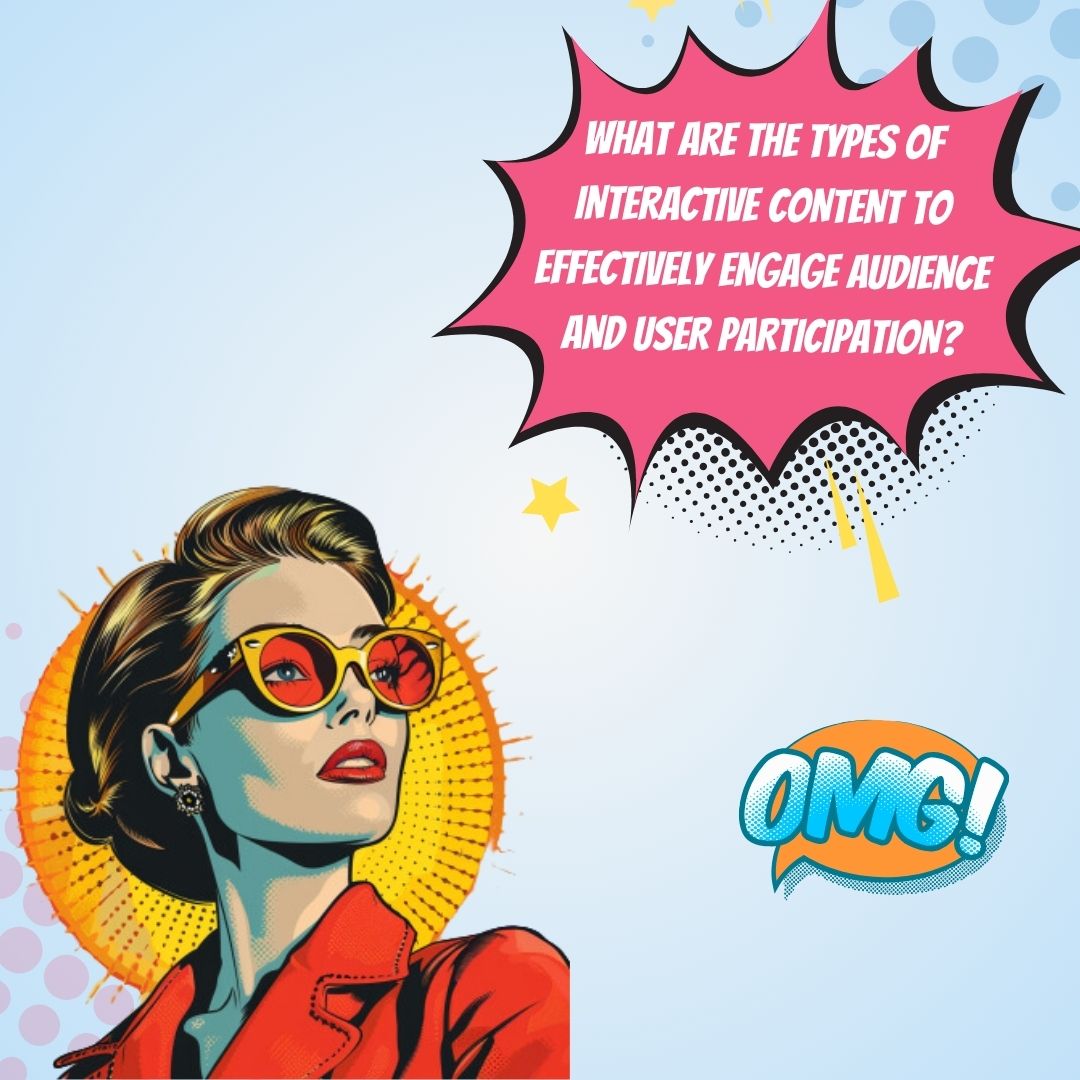Key Takeaways
✅ Interactive content significantly heightens user engagement and conversion rates: Users interacting with content—such as quizzes, polls, or games—tend to stay longer and are more inclined towards completing desired actions. In fact, interactive content has been shown to boost conversion rates by up to 80%, as compared to passive content (Demand Metric).
✅ Gamification and real-time participation foster community and loyalty: Implementing instant rewards or encouraging friendly competition through leaderboards can result in a 22% increase in brand loyalty, according to a recent report by TELUS International. Live interactions not only bring your audience together but also secure their repeat visits.
✅ Leveraging user data and soliciting feedback through interactive content results in personalized experiences: Brands that analyze interaction data can achieve a deeper understanding of their audience, leading to a 20% increase in sales opportunities (Aberdeen Group). Responsive feedback mechanisms are crucial for adapting to your audience’s evolving needs, ensuring satisfaction and better tailored marketing strategies.

Introduction
Have you ever wondered why some brands seem to have a magnetic pull, engaging their audience effortlessly and creating an environment of eager participation? Turns your head, doesn't it? Engaging Your Audience through Creating Interactive Content could be your secret weapon in today’s cutthroat digital marketing arena.
Imagine transforming your content into a two-way conversation, where your audience isn't just passively absorbing information, but actively playing a role in the narrative. With this article, brace yourself for an exciting journey through the landscape of interactive content. You'll unlock modern trends and innovative solutions that can skyrocket your revenue and optimize your ROI. Are you ready to move from static to spectacular? Let's unveil actionable insights and groundbreaking information that will take your content strategy from good to extraordinary.
Top Statistics
| Statistic | Insight |
|---|---|
| 70% of marketers are already using interactive content to engage their audience. | As a vast majority, this captures the clear shift towards interactive experiences as a staple in engaging marketing strategies. |
| Interactive content generates twice as many conversions compared to passive content. | This striking number emphasizes why interactive elements are paramount in driving audience participation and achieving marketing goals. |
| 96% of people who start quizzes on Buzzfeed finish them. | This high completion rate reflects the magnetism of quizzes and similar interactive content in maintaining user engagement. |
| 88% of marketers say interactive content helps brands differentiate themselves from competitors. | Brand distinction is crucial in today's crowded digital landscape, and interactive content stands out as a unique differentiator. |
| 81% of marketers concur that interactive content is significantly more adept at capturing people's attention than static content. | The attention span of users is a precious commodity online; converting it into meaningful engagement is gold for marketers. |
The Power of Interactive Content: Why It Matters
In the realm of marketing, interactive content stands out by creating a two-way conversation with the audience. It's not just about presenting information; it's about getting your audience to interact, play, and think. Why does this matter? Consider this: when someone takes an active role in their content consumption, they're more likely to remember your message. This type of content can be anything from a quick poll on your website to an immersive, game-style product demo. It's the digital equivalent of a friendly handshake – it invites your audience in and, more importantly, keeps them coming back. By utilizing interactive strategies, companies see higher engagement rates and acquire deeper insights into customer preferences.
Designing Engaging Interactive Content: Key Elements
If you’re setting out to make your mark with interactive content, think of it as crafting an irresistible invite to a party. Your content should spark interest, open conversations, and build connections. The key elements lie in offering a narrative vivid enough to captivate the reader and personal enough to reflect their own experiences. Multimedia components such as images, video, and interactive features are no longer optional—they’re crucial in keeping the modern user hooked. Think of these as the party's music and decor—they set the scene and mood. And let’s not forget the party favors: rewards and immediate feedback. They’re the thank you for participating, encouraging your audience to stick around and see what else you have in store.
Gamification and Interactive Content: Boosting Engagement and Learning
When most people hear gamification, they think of points, badges, and leaderboards. However, its true power lies in creating memorable, kinesthetic experiences. By gamifying your content, you're tapping into a fundamental part of human nature—the love of play. This playful approach to content can significantly boost engagement and retention. Imagine a potential customer learning about your services through an interactive story or challenge, rather than a static webpage. This experience not only makes your brand more relatable but also increases the likelihood of your content being shared, creating a ripple effect of brand exposure.

Types of Interactive Content: From Quizzes to Live Videos
Exploring different types of interactive content is like adding various dishes to a buffet; you cater to diverse tastes and preferences. Live videos generate a sense of urgency and community, bringing the audience together for a shared experience. Quizzes and polls, on the other hand, provide personalized insights, inviting users to engage on a personal level. Animations and interactive infographics lead users on a journey through data and narratives. When planning your content, it's crucial to align the format with your objectives. Do you want to educate, entertain, or inspire? Choose your content type accordingly to increase user participation.
Measuring the Success of Interactive Content: Key Metrics
How do you know if your interactive affair was a hit? It's all in the numbers. Engagement metrics like social shares, comments, and likes offer instant feedback on your content's appeal. Meanwhile, detailed metrics like link clicks, session durations, and conversion rates provide deeper insights into user behavior. Tracking these numbers gives you a clearer picture of performance and guides your strategy going forward. Are visitors spending time with your interactive tutorial? Are they clicking through to learn more about your products? Answering these questions will highlight the successes—and pinpoint areas for future improvement.
The Future of Interactive Content
As the digital world spins forward, interactive content isn't just a nice-to-have, it's rapidly becoming an expectation. Users want to feel connected and play an active role in the content they consume. Triggering interaction can set your brand apart, fostering loyalty, and even advocacy. As marketers, our challenge is to stay creative, flexible, and responsive to our audience's evolving needs. This means continuously experimenting with new interactive formats and technologies to create meaningful and memorable content experiences. Looking ahead, interactive content is poised to become even more integrated with other marketing initiatives, solidifying its role in effective digital communication.

AI Marketing Engineers Recommendation
Recommendation 1: Integrate Polls and Surveys into Your Content Strategy: Recent data suggests that integrating polls and surveys can lead to a 30% higher engagement rate compared to passive content. By actively seeking your audience's opinions and preferences, you not only engage them but also collect valuable data for future content and product development. Tailor these interactive elements to reflect current events or trending topics to keep the content timely and relevant.
Recommendation 2: Leverage User-Generated Content to Foster Community: Encouraging users to share their own content can create a sense of community and investment in your brand. As per a 2021 report by Tint, 92% of consumers trust user-generated content more than traditional advertising. Invite your audience to submit stories, photos, or videos related to your brand, and feature them prominently on your platforms. This strategy not only increases engagement but also provides you a rich reservoir of authentic content that resonates with potential customers.
Recommendation 3: Utilize Interactive Video Tools for Enhanced Engagement: Interactive videos have become increasingly popular, with Wyzowl statistics showing that 24% of marketers used them for the first time in 2020. Tools like Wirewax or Rapt Media allow you to create shoppable videos, quizzes, and branching scenarios that let viewers decide what happens next. Such engaging formats can significantly increase time spent with your content and deepen the connection between your brand and its audience.
Relevant Links
- Uncover the Secrets to Success on WeChat
- Master the Art of Short-Video Marketing in China
- Elevate Your Brand with South Korea's Video Marketing Insights
- Dominate South Korea's Online Retail Space with SEO
- Master Your Presence on Google.de with Advanced SEO Techniques
Conclusion
In the vast sea of online content, interactive content stands out as a beacon, capturing the undivided attention and participation of audiences. Remember, it's not just about the content itself, but the experience it creates, turning viewers into active participants and forging a bond that static pages simply can't compete with. Imagine a world where your marketing not only draws eyes but invites the audience to step into it and play a role. That's the kind of immersive journey interactive content offers.
When we design engaging interactive content, we're opening the door to more meaningful interactions. Remember those multimedia elements we talked about? It’s not just bells and whistles; they're the very threads that weave together stories, striking the chords of emotion and interest that bind audiences to your narrative. And let's not forget the measurable returns! By tracking the right metrics, from social engagement to web analytics, we can see the story behind the data, fine-tuning our strategies to hit all the right notes.
Gamification, in its colorful glory, bridges the gap between entertainment and education, forming user associations that last far beyond the initial interaction, and fostering a loyalty that goes deeper than mere brand recognition. The myriad types of interactive content leave us with an extensive palette to draw from, creating unique, tailor-made experiences that resonate on a personal level.
As we look ahead, the future of interactive content shines brightly as a cornerstone of digital marketing. It offers not just a passive window, but a doorway through which users can step into the world we've crafted for them. The question now is, will we continue to innovate and push the boundaries of how we engage, how we share stories, and how we invite participation?
The onus is on us, as creators and marketers, to not merely keep pace, but to lead the charge in the digital narrative. So, take these insights and ask yourself: how will you spark the next wave of user interaction? How will you make your mark in the evolving narrative of engaging your audience?

FAQs
Question 1: How can interactive content engage my audience on my website?
Answer: Interactive content is like a magnet for your website visitors. It adds a spark to their experience by giving them something to play with, something that speaks to them directly. Imagine walking into a room where you can touch and move everything around—it's fun, right? That's what interactive elements do; they turn your website into an inviting space that tempts visitors to stick around and explore.
Question 2: Why is interactive content becoming increasingly popular in digital marketing?
Answer: Think about interactive content as the new kid on the block, the one everyone wants to hang out with. It's fresh, it's engaging, and it gives people a new way to connect with brands. What's not to love about making your experience with a brand feel like you're picking your own adventure? That's why marketers are betting big on this approach.
Question 3: How do interactive quizzes boost audience engagement?
Answer: Quizzes are like the ultimate conversation starters. They get people talking by offering a sneaky peek into who we are. Who doesn't like to find out which superhero they are or what their coffee preferences say about their personality? Quizzes grab attention and, even better, they can teach us a thing or two along the way.
Question 4: How do polls and surveys influence user engagement?
Answer: Have you ever felt a rush when your opinion made a difference? That's the power of polls and surveys. They invite us to weigh in, be heard, and contribute to the conversation. For brands, it's like having a direct line to our thoughts, and for us, it's a chance to speak up and be part of the change.
Question 5: How does interactive content enable real-time audience participation?
Answer: Real-time interaction is like the thrill of a live concert. You're part of the action as it unfolds. Whether it's chatting with your favorite brand during a livestream or answering poll questions in a webinar, you're not just watching; you're in it.
Question 6: How do interactive videos enhance user experience?
Answer: Interactive videos are like those choose-your-own-ending books. Want to learn how to fix a leaky faucet? Choose the path that matches your skill level. It's learning and entertainment rolled into one, except you're in the driver's seat.
Question 7: How does gamification boost website stickiness?
Answer: Gamification is all about bringing out our love for games. Leaderboards, badges, and rewards—it's a mix that can make us stick around just a bit (or a lot) longer, as we chase that top score or the satisfaction of completing a challenge.
Question 8: What are the key benefits of using interactive content for real-time audience participation?
Answer: Real-time participation is like a two-way street; it's rewarding for both sides. For the audience, there's that jolt of excitement from being part of a live moment. And for brands? They get to see the reactions right away, making every interaction feel like a conversation with friends.
Question 9: How can interactive content enhance social engagement?
Answer: When content is fun to interact with, it's even more fun to share. It's like finding a hidden gem and wanting everyone to see it too. And the more it's shared, the more people come to see what the fuss is about, leading to even more conversations and connections.
Question 10: What are the advantages of interactive content?
Answer: Interactive content has the allure of a good party—engaging, enlightening, and shared among friends. It hooks us in, gets us talking, and leaves us with something to remember. With every click or tap, we're telling a story together, one we're all more likely to come back to.

Academic References
- Valenzuela, S., Park, N., & Kee, K. F. (2009). Is There Social Capital in a Social Network Site?: Facebook Use and College Students' Life Satisfaction, Trust, and Participation. Journal of Computer-Mediated Communication, 14(4), 875-901. This paper explores the relationship between Facebook use and the elements of social capital among college students. It provides an in-depth analysis of how interaction and engagement on social networking platforms can translate into offline benefits, including increased life satisfaction and civic participation.
- Kim, A. J., & Ko, E. (2012). Do social media marketing activities enhance customer equity? An empirical study of luxury fashion brand. Journal of Business Research, 65(10), 1480-1486. This study investigates the direct effects of consumers' social media marketing encounters with luxury fashion brands on brand perception and customer equity. The research suggests that interactive social media marketing efforts can significantly influence consumer engagement and brand loyalty.
- Hollebeek, L. D. (2011). Demystifying customer brand engagement: Exploring the loyalty nexus. Journal of Marketing Management, 27(7-8), 785-807. This article offers a comprehensive overview of customer brand engagement, providing a clear conceptual framework. It delves into the dynamics between customer engagement, brand loyalty, and profitability, emphasizing the need for businesses to nurture consumer interactions.








